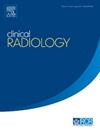Prediction of PD-L1 expression in NSCLC patients using PET/CT radiomics and prognostic modelling for immunotherapy in PD-L1-positive NSCLC patients
IF 2.1
3区 医学
Q2 RADIOLOGY, NUCLEAR MEDICINE & MEDICAL IMAGING
引用次数: 0
Abstract
AIM
To develop a positron emission tomography/computed tomography (PET/CT)-based radiomics model for predicting programmed cell death ligand 1 (PD-L1) expression in non-small cell lung cancer (NSCLC) patients and estimating progression-free survival (PFS) and overall survival (OS) in PD-L1-positive patients undergoing first-line immunotherapy.
MATERIALS AND METHODS
We retrospectively analysed 143 NSCLC patients who underwent pretreatment 18F-fluorodeoxyglucose (18F-FDG) PET/CT scans, of whom 86 were PD-L1-positive. Clinical data collected included gender, age, smoking history, Tumor-Node-Metastases (TNM) staging system, pathologic types, laboratory parameters, and PET metabolic parameters. Four machine learning algorithms—Bayes, logistic, random forest, and Supportsupport vector machine (SVM)—were used to build models. The predictive performance was validated using receiver operating characteristic (ROC) curves. Univariate and multivariate Cox analyses identified independent predictors of OS and PFS in PD-L1-positive expression patients undergoing immunotherapy, and a nomogram was created to predict OS.
RESULTS
A total of 20 models were built for predicting PD-L1 expression. The clinical combined PET/CT radiomics model based on the SVM algorithm performed best (area under curve for training and test sets: 0.914 and 0.877, respectively). The Cox analyses showed that smoking history independently predicted PFS. SUVmean, monocyte percentage and white blood cell count were independent predictors of OS, and the nomogram was created to predict 1-year, 2-year, and 3-year OS based on these three factors.
CONCLUSION
We developed PET/CT-based machine learning models to help predict PD-L1 expression in NSCLC patients and identified independent predictors of PFS and OS in PD-L1-positive patients receiving immunotherapy, thereby aiding precision treatment.
利用PET/CT放射组学预测PD-L1在非小细胞肺癌患者中的表达,并对PD-L1阳性非小细胞肺癌患者的免疫治疗进行预后建模
目的:建立基于正电子发射断层扫描/计算机断层扫描(PET/CT)的放射组学模型,预测非小细胞肺癌(NSCLC)患者的程序性细胞死亡配体1 (PD-L1)表达,并估计接受一线免疫治疗的PD-L1阳性患者的无进展生存期(PFS)和总生存期(OS)。材料和方法我们回顾性分析了143例接受18f -氟脱氧葡萄糖(18F-FDG)预处理PET/CT扫描的非小细胞肺癌患者,其中86例pd - l1阳性。收集的临床资料包括性别、年龄、吸烟史、肿瘤-淋巴结-转移(TNM)分期系统、病理类型、实验室参数和PET代谢参数。四种机器学习算法-贝叶斯,逻辑,随机森林和支持支持向量机(SVM) -被用来建立模型。采用受试者工作特征(ROC)曲线验证预测效果。单因素和多因素Cox分析确定了pd - l1阳性表达患者接受免疫治疗的OS和PFS的独立预测因素,并创建了一个nomogram来预测OS。结果共建立了20个预测PD-L1表达的模型。基于SVM算法的临床PET/CT联合放射组学模型表现最好(训练集和测试集曲线下面积分别为0.914和0.877)。Cox分析显示,吸烟史可以独立预测PFS。SUVmean、单核细胞百分比和白细胞计数是OS的独立预测因子,并基于这三个因素创建了预测1年、2年和3年OS的nomogram。我们开发了基于PET/ ct的机器学习模型来帮助预测NSCLC患者的PD-L1表达,并确定了接受免疫治疗的PD-L1阳性患者PFS和OS的独立预测因子,从而有助于精确治疗。
本文章由计算机程序翻译,如有差异,请以英文原文为准。
求助全文
约1分钟内获得全文
求助全文
来源期刊

Clinical radiology
医学-核医学
CiteScore
4.70
自引率
3.80%
发文量
528
审稿时长
76 days
期刊介绍:
Clinical Radiology is published by Elsevier on behalf of The Royal College of Radiologists. Clinical Radiology is an International Journal bringing you original research, editorials and review articles on all aspects of diagnostic imaging, including:
• Computed tomography
• Magnetic resonance imaging
• Ultrasonography
• Digital radiology
• Interventional radiology
• Radiography
• Nuclear medicine
Papers on radiological protection, quality assurance, audit in radiology and matters relating to radiological training and education are also included. In addition, each issue contains correspondence, book reviews and notices of forthcoming events.
 求助内容:
求助内容: 应助结果提醒方式:
应助结果提醒方式:


